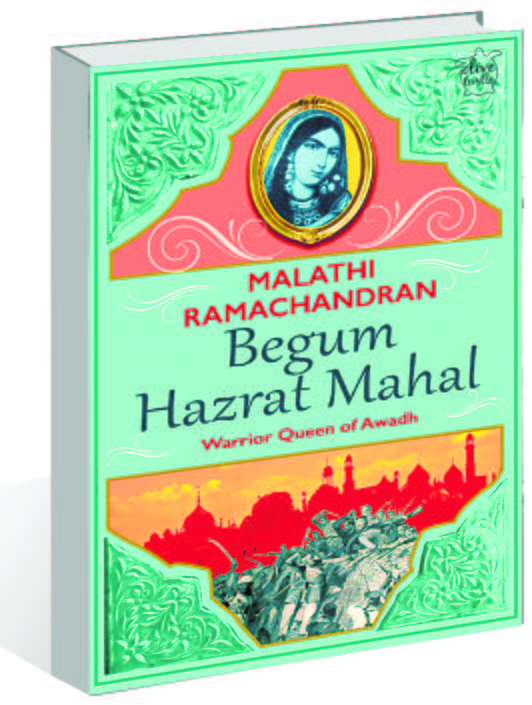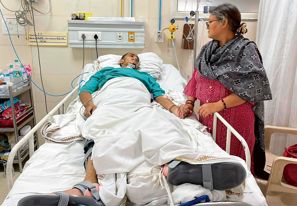Begum Hazrat Mahal: Warrior Queen of Awadh by Malathi Ramachandran. Niyogi Books. Pages 330. Rs 595
Book Title: Begum Hazrat Mahal: Warrior Queen of Awadh
Author: Malathi Ramachandran
Salil Misra
In 1857, the British rule in India was hit by a huge tsumani which shook its foundations. It started from Bengal with Mangal Pandey’s rebellion and soon reached Delhi, Lucknow, Jhansi, Kanpur and many other places. It lasted for a whole year and subsided by the end of 1858 without meeting its objective. The book under review tells the story of the rebellion through one of its central characters, Begum Hazrat Mahal. It belongs to the genre of historical fiction. To her credit, Malathi Ramachandran, the author, has not fictionalised history and has remained as close to the actual historical process as possible. All the historical events and many of the characters described in the novel are real. Using history as the backdrop, the author has created a fictionalised world around the life of Hazrat Mahal. The account is authentic, enchanting and tragic, at the same time.
Begum Hazrat Mahal was the queen of Nawab Wajid Ali Shah of Awadh. When he was dethroned by the British and exiled to Calcutta, she chose not to go with him and instead stayed behind in her beloved Lucknow along with her 12-year-old son Birjis Qadir. The novel tells the story of how she fought the British in Awadh with a fierce determination to expel them from both Awadh and Hindustan. In this venture, she was helped by a strong team of local rulers who were just as patriotic and fiercely anti-British. In the war against the British, Hazrat Mahal had the full support of the merchants, zamindars and the local people. They organised a successful siege of the Residency in June 1857 with around 3,000 British hostages, both officials and civilians. The battle was evenly matched. The rebels were confident of victory. “We have over five thousand men to their seven hundred!” claimed one of the rebels. It was a battle between raw passion, patriotism and fierce determination on the one side and the mighty British imperialism on the other. The outcome of the battle was not clear to the actors involved. Their resources were evenly matched. The rebels were short on ammunition and were at risk of running out of it. But there was no shortage of food and other amenities, all of which were generously supplied by the people.
It was just the other way round for the British. They had the weapons but were greatly at risk of being starved to death inside the Residency because of scarcity of food. The rebels were optimistic; the British low in morale. Finally, the British were rescued by the arrival of supplies from Kanpur and that turned the tables on the rebels. The battle took a very different turn. We now know that eventually the mighty British imperialism with its great support system triumphed over the patriotism of Hazrat Mahal. Awadh was recaptured by the British. The queen exiled herself and her son to Nepal towards the end of 1858.
The historical novel proceeds at three levels. At the macro level, it tells the story of the great pan-Indian encounter between British imperialism and the great resistance to it from different parts of the country. It culminated in the Rebellion of 1857. The second level offers an important slice of that rebellion as it unfolded in Awadh, particularly during May-October 1857. There were crucial episodes of struggle in this rebellion with Begum Hazrat Mahal as the leader. At the micro level, however, the novel tells the stories of important individuals with their dilemmas and predicaments. It also tells the story of love, longing, lust and betrayal. A particularly endearing character is that of Kamla, who experiences a romantic life in the midst of the turmoil. She and a young British officer, James Grant, fall in love with each other. She carries their baby in her womb with the promise of marriage at the end of the rebellion. However, Kamla soon discovers that he has no intentions of fulfilling the promise. Her love turns into rage, both against James Grant and the British. Kamla decides to follow Hazat Mahal and joins her army by becoming a Veerangini (warrior). She fights the British army valiantly and also makes a determined though unsuccessful effort at eliminating the once-upon-a-time love of her life. The novel offers a glimpse of many such people — birds caught in a storm — whose lives are changed forever.
It is a novel whose climax happens not at the end but somewhere in the middle, with the prospects of a victory for the rebels. The novel ends tragically, not with a bang but with a whimper. That was exactly how the Rebellion of 1857 ended. It would take a whole century for multiple patriotisms to transform into a robust Indian nationalism which would eventually achieve what 1857 could not.














